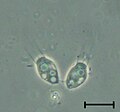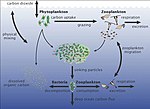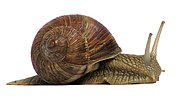or clade. Therefore, some protists may be more closely related to animals, plants, or fungi than they are to other protists. However, like algae, invertebrates...
70 KB (7,729 words) - 07:09, 4 January 2024
A protist (/ˈproʊtɪst/ PROH-tist) or protoctist is any eukaryotic organism that is not an animal, land plant, or fungus. Protists do not form a natural...
94 KB (9,774 words) - 00:15, 19 May 2024
climate and human activity. Paleovirology Protists in the fossil record List of prehistoric foraminiferans The Micropalaeontological Society Drewes, Charlie...
16 KB (1,485 words) - 20:05, 21 April 2024
Microfossil (redirect from Micro-fossil)
Gunflint microfossils Macrofossil Protists in the fossil record Protist shell Scale microfossils Small carbonaceous fossil Slater, Ben J.; Harvey, Thomas...
61 KB (6,330 words) - 16:26, 22 May 2024
Coccolithophore shells Many protists have protective shells or tests, usually made from silica (glass) or calcium carbonate (chalk). Protists are a diverse group...
41 KB (3,833 words) - 23:31, 29 March 2024
living fossil is an extant taxon that phenotypically resembles related species known only from the fossil record. To be considered a living fossil, the fossil...
46 KB (4,819 words) - 00:43, 4 June 2024
Xenophyophorea (section Fossil record)
Legouta, Anton (2003-03-31). "Ediacaran biota: The dawn of animal life in the shadow of giant protists". Paleontological Research. 7 (1): 43–54. doi:10...
35 KB (3,883 words) - 19:30, 18 May 2024
Paleontology (redirect from Fossil taxon)
Paleobotany studies fossil plants, algae, and fungi. Palynology, the study of pollen and spores produced by land plants and protists, straddles paleontology...
102 KB (10,179 words) - 08:27, 3 June 2024
Taxonomy of Protista (section Endomyxa Cavalier-Smith 2002, emend. Bass & Berney in Adl et al. 2019)
A protist (/ˈproʊtɪst/) is any eukaryotic organism (one with cells containing a nucleus) that is not an animal, plant, or fungus. The protists do not form...
202 KB (15,231 words) - 19:51, 28 May 2024
Ediacaran biota (redirect from Ediacaran fossils)
as the Cambrian explosion. Most of the currently existing body plans of animals first appeared in the fossil record of the Cambrian rather than the Ediacaran...
104 KB (11,018 words) - 19:02, 22 May 2024
Nassellaria (section Fossil History)
aesthetically interesting protists both alive and in the fossil record. They occupy an important role ecologically and have done so since the Precambrian. There...
11 KB (1,154 words) - 19:02, 20 November 2023
Marine life (redirect from Life in the ocean)
typically macroscopic. Most protists are single-celled and microscopic. But there are exceptions. Some single-celled marine protists are macroscopic. Some marine...
304 KB (29,027 words) - 03:21, 16 May 2024
Vendobionta (section Comparison with protists)
correspond to the articulated ones. This type of symmetry is not typical in animals; instead, it has been observed in other vendobionts, protists, multicellular...
22 KB (2,575 words) - 05:58, 16 May 2024
Foraminifera (section Variations in reproductive mode)
are single-celled organisms, members of a phylum or class of Rhizarian protists characterized by streaming granular ectoplasm for catching food and other...
86 KB (8,432 words) - 03:59, 12 May 2024
Radiolaria (section Fossil record)
unicellular predatory protists encased in elaborate globular shells usually made of silica and pierced with holes. Their name comes from the Latin for "radius"...
27 KB (2,546 words) - 11:41, 31 May 2024
Paleodictyon nodosum (category Trace fossils)
Paleodictyon nodosum may actually be a large protist. There are other known examples of protists reaching the sizes that Paleodictyon reaches, and they are...
10 KB (1,272 words) - 02:01, 7 November 2023
Wastebasket taxon (section Wastebasket taxa in science)
Roy E.; Wagner, Peter J. (2006). "Round up the Usual Suspects: Common Genera in the Fossil Record and the Nature of Wastebasket Taxa". Paleobiology. 32...
10 KB (1,210 words) - 18:55, 14 April 2024
Small shelly fauna (redirect from Small shelly fossil)
The small shelly fauna, small shelly fossils (SSF), or early skeletal fossils (ESF) are mineralized fossils, many only a few millimetres long, with a...
40 KB (4,941 words) - 19:09, 1 April 2024
Dictyochales (category Taxa described in 1894)
The silicoflagellates (order Dictyochales) are a small group of unicellular photosynthetic protists, or algae, belonging to the supergroup of eukaryotes...
16 KB (1,165 words) - 15:01, 11 April 2024
Eukaryote (category All Wikipedia articles written in American English)
are typically unicellular. Unicellular eukaryotes are sometimes called protists. Eukaryotes can reproduce both asexually through mitosis and sexually through...
61 KB (6,038 words) - 05:34, 29 May 2024
Marine protists Marine protists are defined by their habitat as protists that live in marine environments, that is, in the saltwater of seas or oceans...
132 KB (10,594 words) - 10:32, 2 June 2024
Invertebrate paleontology (redirect from Invertebrate fossils)
discipline is the scientific study of prehistoric invertebrates by analyzing invertebrate fossils in the geologic record. By invertebrates are meant the non-vertebrate...
11 KB (1,212 words) - 22:50, 1 May 2022
Journal of Foraminiferal Research, Cushman Foundation Loeblich & Tappin, 1964. Treatise on Invertebrate Paleontology, Part C Protists in the fossil record...
48 KB (2,149 words) - 00:22, 2 August 2023
Thomas Cavalier-Smith in 1991 to refer to a group of basal protists that later proved not to form a clade. This group had the rank of phylum and contained...
11 KB (1,113 words) - 08:35, 18 May 2024
Marine microorganisms (section Marine protists)
protists, but recent studies in marine environments found mixotrophic protests contribute a significant part of the protist biomass. Since protists are...
232 KB (21,388 words) - 09:31, 2 June 2024
Largest organisms (section Protists)
photosynthetic unicellular and multicellular protists that are related to land plants. The thallus of the unicellular mermaid's wineglass, Acetabularia...
22 KB (3,082 words) - 13:45, 1 June 2024
Animal (section In human culture)
within Bilateria. Animals first appear in the fossil record in the late Cryogenian period, and diversified in the subsequent Ediacaran. Earlier evidence...
125 KB (11,168 words) - 02:30, 4 June 2024
Tintinnid (section Fossil record)
at all. Fossils which can be reliably related to extant tintinnids (e.g. fossils of agglutinated lorica) are in the fossil record during the Jurassic...
7 KB (729 words) - 16:26, 15 October 2023
Mollusca (category Wikipedia articles incorporating a citation from the 1911 Encyclopaedia Britannica with Wikisource reference)
of molluscs are recognized. The number of fossil species is estimated between 60,000 and 100,000 additional species. The proportion of undescribed species...
93 KB (9,446 words) - 05:42, 1 June 2024
Holozoa (category Taxa described in 2002)
is therefore paraphyletic. The holozoan protists play a crucial role in understanding the evolutionary steps leading to the emergence of multicellular...
31 KB (3,099 words) - 15:59, 24 February 2024

























